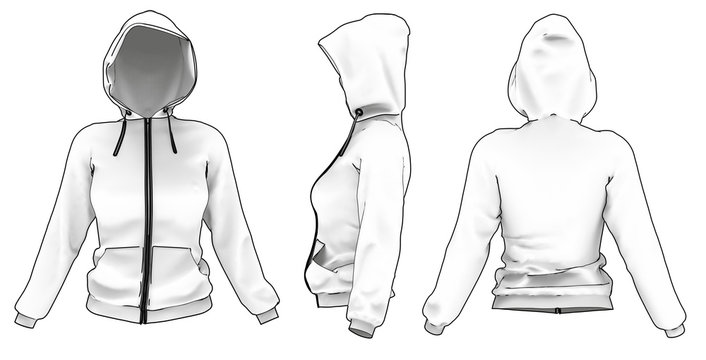
Let's break down the key points on women's hoodies and sweatshirts, covering various aspects like making, personality development, types, care, pros and cons, pattern cutting, material choices, fashion, design trends, market insights, and customer preferences.
1. Making
Design and Conceptualization:
Target Audience: Define the demographic and psychographic details of your target customers.
Sketching: Start with initial sketches to visualize the design.
Prototyping: Create prototypes to test design, fit, and functionality.
Pattern Cutting:
Measurements: Accurate measurements are essential for a good fit.
Pattern Blocks: Develop pattern blocks for different sizes.
Pattern Cutting Tools: Use tools like rulers, pattern paper, and cutting tools to create precise patterns.
Material Selection:
Fabric Types: Cotton, polyester, fleece, and blends are common materials.
Fabric Weight: Choose the fabric weight based on the season and intended use (lightweight for summer, heavyweight for winter).
Sustainability: Consider eco-friendly materials like organic cotton or recycled polyester.
2. Types
Pullover Hoodies: No zippers, often feature a front pocket (kangaroo pocket).
Zip-Up Hoodies: Include a full-length zipper for easy wear and removal.
Crewneck Sweatshirts: No hood, simpler design.
Oversized Hoodies: Larger fit for a casual, relaxed look.
Cropped Hoodies: Shorter length, trendy and fashionable.
Performance Hoodies: Made with moisture-wicking materials for sports and physical activities.
3. Care
Washing: Wash with similar colors, use a gentle cycle, and cold water to prevent shrinking and color fading.
Drying: Air dry if possible to maintain fabric integrity; avoid high heat in dryers.
Storage: Store folded to prevent stretching, particularly for knit fabrics.
4. Good Side (Pros)
Comfort: Soft fabrics and relaxed fits make hoodies and sweatshirts extremely comfortable.
Versatility: Can be dressed up or down depending on the occasion.
Warmth: Provides warmth, especially when layered.
Durability: High-quality materials can last a long time with proper care.
5. Bad Side (Cons)
Bulkiness: Some designs can be bulky and less flattering for certain body types.
Heat Retention: Can be too warm for certain climates or activities.
Maintenance: Some materials may require special care to avoid damage.
6. Pattern Cutting
Basic Blocks: Start with basic block patterns that fit well.
Adjustments: Adjust the pattern for different styles (e.g., adding a hood or pockets).
Grading: Create patterns for different sizes using grading techniques.
7. Material Choice
Cotton: Breathable and comfortable but can shrink.
Polyester: Durable and moisture-wicking but less breathable.
Fleece: Warm and soft, ideal for colder weather.
Blends: Combine the best properties of different materials.
8. Fashion and Design Trends
Athleisure: Combining athletic wear with casual fashion.
Sustainability: Growing demand for eco-friendly and sustainable materials.
Customization: Personalized prints, embroidery, and patches.
Vintage and Retro Styles: Nostalgic designs from past decades.
9. Market Insights
Customer Preferences: Trend towards comfortable and versatile clothing.
Online Shopping: Significant growth in e-commerce for apparel.
Sustainability: Increasing awareness and demand for sustainable fashion.
10. Customer Preferences
Comfort and Fit: Customers prioritize comfort and a good fit.
Design and Style: Unique designs and trendy styles attract customers.
Quality and Durability: High-quality materials and construction are key.
Conclusion
Women�s hoodies and sweatshirts are a staple in modern wardrobes, valued for their comfort, versatility, and style. By understanding the intricacies of making, pattern cutting, material selection, and market trends, you can create products that meet customer expectations and stand out in the market. Always consider the balance between fashion trends and the practical needs of the consumer.